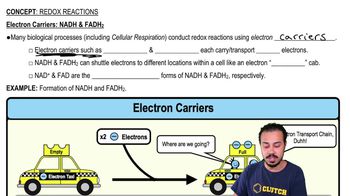Which of the following compounds has the greatest amount of energy for a cell?
a. CO₂
b. ATP
c. glucose
d. O₂
e. lactic acid
 Verified step by step guidance
Verified step by step guidance


Which of the following compounds has the greatest amount of energy for a cell?
a. CO₂
b. ATP
c. glucose
d. O₂
e. lactic acid
Define oxidation-reduction, and differentiate the following terms:
a. aerobic and anaerobic respiration
b. respiration and fermentation
c. cyclic and noncyclic photophosphorylation
There are three mechanisms for the phosphorylation of ADP to produce ATP. Write the name of the mechanism that describes each of the reactions in the following table.
<IMAGE>
All of the energy-producing biochemical reactions that occur in cells, such as photophosphorylation and glycolysis, are ________ reactions.
Which of the following is the best definition of cellular respiration?
a. a sequence of redox reactions with O₂ as the final electron acceptor
b. a sequence of redox reactions with the final electron acceptor from the environment
c. a method of generating ATP
d. the complete oxidation of glucose to CO₂ and H₂O
e. a series of reactions in which pyruvic acid is oxidized to CO₂ and H₂O
Fill in the following table with the carbon source and energy source of each type of organism.
<IMAGE>